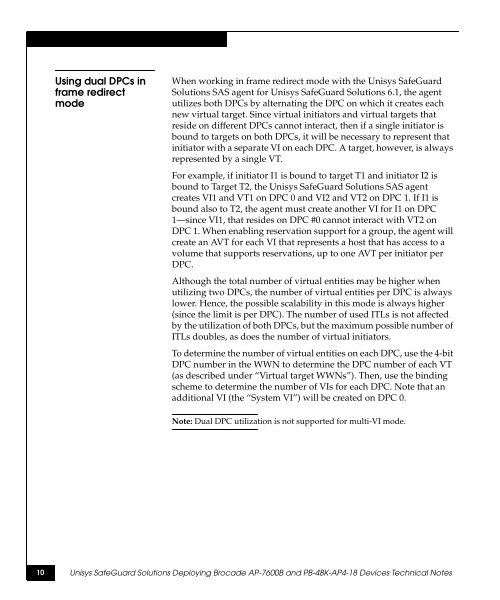SafeGuard Solutions Deploying Brocade AP-7600B and PB-48K ...
SafeGuard Solutions Deploying Brocade AP-7600B and PB-48K ...
SafeGuard Solutions Deploying Brocade AP-7600B and PB-48K ...
You also want an ePaper? Increase the reach of your titles
YUMPU automatically turns print PDFs into web optimized ePapers that Google loves.
Using dual DPCs in<br />
frame redirect<br />
mode<br />
When working in frame redirect mode with the Unisys <strong>SafeGuard</strong><br />
<strong>Solutions</strong> SAS agent for Unisys <strong>SafeGuard</strong> <strong>Solutions</strong> 6.1, the agent<br />
utilizes both DPCs by alternating the DPC on which it creates each<br />
new virtual target. Since virtual initiators <strong>and</strong> virtual targets that<br />
reside on different DPCs cannot interact, then if a single initiator is<br />
bound to targets on both DPCs, it will be necessary to represent that<br />
initiator with a separate VI on each DPC. A target, however, is always<br />
represented by a single VT.<br />
For example, if initiator I1 is bound to target T1 <strong>and</strong> initiator I2 is<br />
bound to Target T2, the Unisys <strong>SafeGuard</strong> <strong>Solutions</strong> SAS agent<br />
creates VI1 <strong>and</strong> VT1 on DPC 0 <strong>and</strong> VI2 <strong>and</strong> VT2 on DPC 1. If I1 is<br />
bound also to T2, the agent must create another VI for I1 on DPC<br />
1—since VI1, that resides on DPC #0 cannot interact with VT2 on<br />
DPC 1. When enabling reservation support for a group, the agent will<br />
create an AVT for each VI that represents a host that has access to a<br />
volume that supports reservations, up to one AVT per initiator per<br />
DPC.<br />
Although the total number of virtual entities may be higher when<br />
utilizing two DPCs, the number of virtual entities per DPC is always<br />
lower. Hence, the possible scalability in this mode is always higher<br />
(since the limit is per DPC). The number of used ITLs is not affected<br />
by the utilization of both DPCs, but the maximum possible number of<br />
ITLs doubles, as does the number of virtual initiators.<br />
To determine the number of virtual entities on each DPC, use the 4-bit<br />
DPC number in the WWN to determine the DPC number of each VT<br />
(as described under “Virtual target WWNs”). Then, use the binding<br />
scheme to determine the number of VIs for each DPC. Note that an<br />
additional VI (the “System VI”) will be created on DPC 0.<br />
Note: Dual DPC utilization is not supported for multi-VI mode.<br />
10 Unisys <strong>SafeGuard</strong> <strong>Solutions</strong> <strong>Deploying</strong> <strong>Brocade</strong> <strong>AP</strong>-<strong>7600B</strong> <strong>and</strong> <strong>PB</strong>-<strong>48K</strong>-<strong>AP</strong>4-18 Devices Technical Notes
















